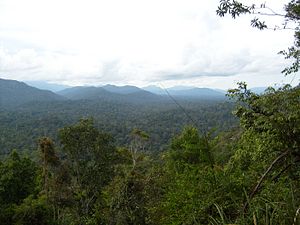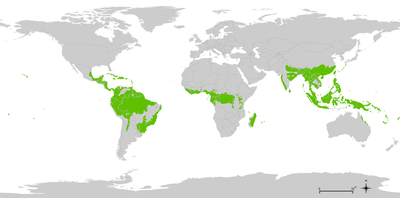
Tropical rainforest
About this schools Wikipedia selection
SOS Children, which runs nearly 200 sos schools in the developing world, organised this selection. Click here to find out about child sponsorship.

A tropical rainforest is a biome found within (roughly) 10 degrees north or south of the equator. They are common in Asia, Australia, Africa, South America, Central America, Mexico and on many of the Pacific Islands. Within the World Wildlife Fund's biome classification, tropical rainforests are considered a type of tropical wet forest (or tropical moist broadleaf forest) and may also be referred to as lowland equatorial evergreen rainforest. Minimum normal annual rainfall between 1,750 millimetres (69 in) and 2,000 millimetres (79 in) occurs in this climate region. Mean monthly temperatures exceed 18 °C (64 °F) during all months of the year. Rainforests are home to half of all the living animal and plant species on the planet. Tropical rain forests are called the "world's largest pharmacy" because over one-quarter of modern medicines originate from its plants. The undergrowth in a rainforest is restricted in many areas by the lack of sunlight at ground level. This makes it possible for people and other animals to walk through the forest. If the leaf canopy is destroyed or thinned for any reason, the ground beneath is soon colonized by a dense tangled growth of vines, shrubs and small trees called a jungle.
Characteristics
The rainforests are home to more species or populations than all other biomes added together. 80% of the world's biodiversity are found in tropical rainforests. The leafy tops of tall trees - extending from 50 to 85 meters above the forest floor - forms an understory. Organic matter that falls to the forest floor quickly decomposes, and the nutrients are recycled.
Rainforests are characterized by high rainfall. This often results in poor soils due to leaching of soluble nutrients. Oxisols, as are the soils of many seasonally flooded forests, which are annually replenished with fertile silt.
Tropical rain forests have been subjected to heavy logging and agricultural clearance throughout the 20th century, and the area covered by rainforests around the world is rapidly shrinking.
Rainforests are also often called the "Earth's lungs," however there is no scientific basis for such a claim as tropical rainforests are known to be essentially oxygen neutral, with little or no net oxygen production.
Tall, broad-leaved evergreen trees are the dominant plants, forming a leafy canopy over the forest floor. Taller trees, called emergents, may rise above the canopy. The upper portion of the canopy often supports a rich flora of epiphytes, including orchids, bromeliads, mosses, and lichens, who live attached to the branches of trees. The undergrowth or understory in a rain forest is often restricted by the lack of sunlight at ground level, and generally consists of shade-tolerant shrubs, herbs, ferns, small trees, and large woody vines which climb into the trees to capture sunlight. The relatively sparse under story vegetation makes it possible for people and other animals to walk through the forest. In deciduous and semi-deciduous forests, or forests where the canopy is disturbed for some reason, the ground beneath is soon colonized by a dense tangled growth of vines, shrubs and small trees called jungle.
The temperature ranges from 15 to 50°C and 125 to 660 cm of rainfall yearly
Layers
The rainforest is divided into five different layers, each with different plants and animals, adapted for life in the particular area. These are: the ground layer, the shrub layer, the understorey layer, the canopy layer and the emergent layer. Only the emergent layer is unique to tropical rainforests, while the others are also found in temperate rainforests.
The emergent layer contains a small number of very large trees which grow above the canopy layer, reaching heights of 45-55 m, although on occasion a few species will grow up to 70 m or 80 m tall. They need to be able to withstand the hot temperatures and strong winds. Eagles, butterflies, bats and certain monkeys inhabit this layer.
The canopy is the primary layer of the forest and forms a roof over the two remaining layers. Most canopy trees have smooth, oval leaves that come to a point. It's a maze of leaves and branches. Many animals live in this area since food is abundant. Those animals include: snakes, toucans and tree frogs.
Little sunshine reaches the understory layer, so the plants have to grow larger leaves to obtain sufficient sunlight. The plants in this area seldom grow to 12 feet. Many animals live here including jaguars, red-eyed tree frogs and leopards. There is a large concentration of insects here.
The shrub layer and forest floor are very dark. Few plants grow in this area, as a result. Since hardly any sun reaches the forest floor things begin to decay quickly. A leaf that might take one year to decompose in a regular climate will disappear in 6 weeks. Giant anteaters live in this layer.
Human uses
Habitation
Tropical rainforests are unable to support human life. Food resources within the forest are extremely dispersed due to the high biological diversity and what food does exist is largely restricted to the canopy and requires considerable energy to obtain. Some groups of hunter-gatherers have exploited rainforest on a seasonal basis but dwelt primarily in adjacent savanna and open forest environments where food is much more abundant. Other peoples described as rainforest dwellers are hunter-gatherers who subsist in large part by trading high value forest products such as hides, feathers, and honey with agricultural people living outside the forest.
Conversion to agricultural land
With the invention of agriculture, humans were able to clear sections of rainforest to produce crops, converting it to open farmland. Such people, however, obtain their food primarily from farm plots cleared from the forest and hunt and forage within the forest to supplement this.
Agriculture on formerly forested land is not without difficulties. Rainforest soils are often thin and leached of many minerals, and the heavy rainfall can quickly leach nutrients from area cleared for cultivation. People such as the Yanomamo of the Amazon, utilise slash-and-burn agriculture to overcome these limitations and enable them to push deep into what were previously rainforest environments. However, these are not rainforest dwellers, rather they are dwellers in cleared farmland that make forays into the rainforest. Up to 90% of the typical Yanamomo diet comes from farmed plants.
Cultivated foods and spices
Coffee, chocolate, banana, mango, papaya, macadamia, avocado, and sugarcane all originally came from tropical rainforest and are still mostly grown on plantations in regions that were formerly primary forest. In the mid-1980s and 90s, 40 million tons of bananas were consumed worldwide each year, along with 13 million tons of mangos. Central American coffee exports were worth US$3 billion in 1970. Much of the genetic variation used in evading the damage caused by new pests is still derived from resistant wild stock. Tropical forests have supplied 250 cultivated kinds of fruit, compared to only 20 for temperate forests. Forests in New Guinea alone contain 251 tree species with edible fruits, of which only 43 had been established as cultivated crops by 1985.
Ecosystem services
In addition to extractive human uses rain forests also have non-extractive uses that are frequently summarized as ecosystem services. Rain forests play an important role in maintaining biological diversity, modulating precipitation, infiltration and flooding and by increasing scientific knowledge.



